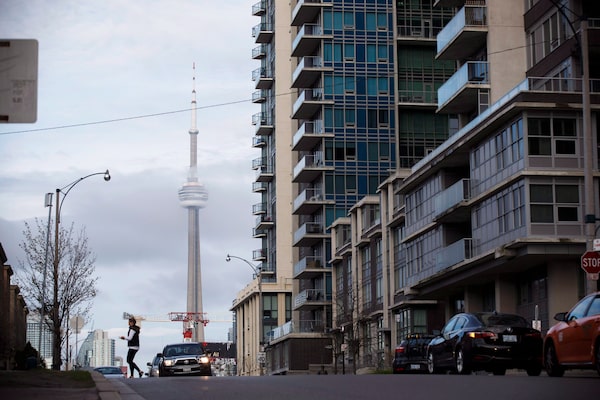
Policy makers and the public have started to pay closer attention to investors’ role in the price spiral as the country’s affordable housing problem increases.COLE BURSTON/The Canadian Press
More than 40 per cent of condos in Ontario are investment properties, with investor ownership in excess of 80 per cent in smaller metropolitan areas such as London, Sarnia and Woodstock.
The numbers come from a new report by the Canadian Housing Statistics Program (CHSP), which shows for the first time the extent of investors’ reach in the country’s largest real estate market, as well as in B.C. and three other provinces.
The report pulled data from early 2020, prior to the start of the pandemic, and before the ensuing frenzy that drove home prices up more than 50 per cent across the country. Policy makers and the public have started to pay closer attention to investors’ role in the price spiral as the country’s affordable housing problem increases.
Toronto home prices flattened, market slowdown eased in January
There are fewer apartments available to rent in Canada than at any time since 2001
CHSP’s report shows that investment properties make up 36.2 per cent of condos in B.C.; 36.6 per cent in Nova Scotia; 29.2 per cent in Manitoba and 22.6 per cent in New Brunswick.
And investors have increasingly dominated the condo market. They own about half of the condos built from 2016 through early 2020, according to CHSP, which is a Statscan program and uses property lists, tax filings, census data and land-registry information for its research.
The report does not include all parts of Canada, such as Alberta and Quebec, because not all provinces and institutions co-operated with Statscan.
“When properties are owned by investors, they can contribute to the rental housing supply and therefore meet the population’s need for rental housing,” wrote the authors, Statscan senior analysts Joanie Fontaine and Joshua Gordon. “But that can also limit the number of properties available to buyers who intend to use it as a primary place of residence.”
In less-populated areas outside of the Toronto region, investors owned a significant percentage of the condo units. In the Woodstock area, the share of investment-owned condos was 95 per cent, according to CHSP. In Sarnia, it was 86.9 per cent; London was at 86.4 per cent and Chatham-Kent was 83.9 per cent.
The researchers found that domestic individuals and domestic businesses, which include personal real estate corporations, owned the bulk of the investment properties. Foreigners or non-residents owned 7 per cent of the condos in B.C. and 5.6 per cent in Ontario.
“Most of the investment properties were owned by an individual who lived in the province,” said Ms. Fontaine.
Andy Yan, director of Simon Fraser University’s city program, said the report highlights the commodification of the Canadian housing market.
“We talk about building more but building more for whom. Are you building for people looking for their first home or are you building for people looking for their next investment,” he said.
The CHSP report found that in early 2020, more than one in five property owners was an investor. That complements Bank of Canada research that found that investor-buying doubled over the first year of the pandemic’s real estate boom and accounted for one-fifth of all residential purchases by mid-2021.
National housing agency Canada Mortgage and Housing Corp. has repeatedly said that investors play an important role in the rental market given the dearth of units that are specifically dedicated for rental – also known as purpose-built rental or apartment units. Condos account for nearly one-fifth of the country’s total rental stock, according to CMHC. In Vancouver, they account for 42.5 per cent and in Toronto 34 per cent.
CHSP was established after the 2016 real estate boom in Toronto and Vancouver to help fill the large data gaps in the country’s residential real estate market.
It defines an investor as an owner who owns at least one residential property that is not used as their primary place of residence. And an investment property has been defined as residential real estate owned by at least one investor that is not the primary place of residence of any of the owners.